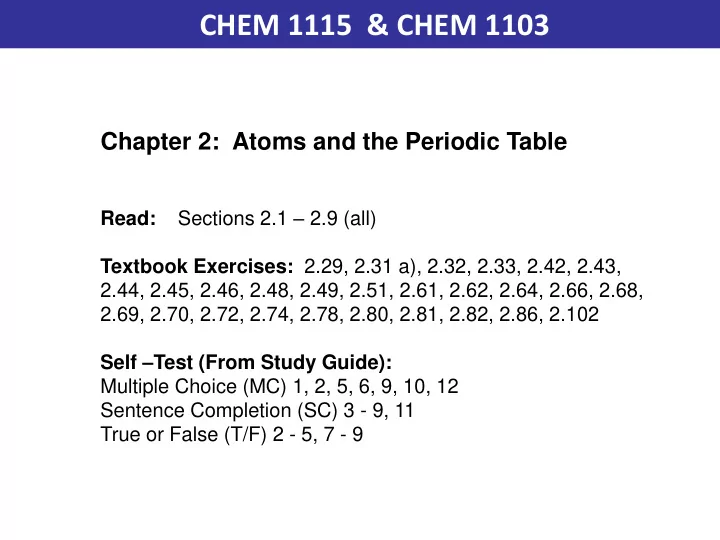

CHEM 1115 & CHEM 1103 Chapter 2: Atoms and the Periodic Table Read: Sections 2.1 – 2.9 (all) Textbook Exercises: 2.29, 2.31 a), 2.32, 2.33, 2.42, 2.43, 2.44, 2.45, 2.46, 2.48, 2.49, 2.51, 2.61, 2.62, 2.64, 2.66, 2.68, 2.69, 2.70, 2.72, 2.74, 2.78, 2.80, 2.81, 2.82, 2.86, 2.102 Self – Test (From Study Guide): Multiple Choice (MC) 1, 2, 5, 6, 9, 10, 12 Sentence Completion (SC) 3 - 9, 11 True or False (T/F) 2 - 5, 7 - 9
Atomic Structure: Modern model
Molecular Man What do atoms look like? Carbon monoxide molecules on platinum surface (Image from a scanning tunneling microscope)
The Japanese characters for “atom” written with atoms
Atomic Structure: Modern model Nucleus: Protons and neutrons (each about equal mass) • Most of mass • Very little volume • Outside Nucleus: Electrons • Very little mass • Most of atom’s volume •
Atomic Structure: An analogy Average distance to If this basketball electron would be 2.5 km were a hydrogen atom’s nucleus…
Atomic Structure: Composition Subatomic particle Mass Charge 1.673 x 10 -24 g Proton +1 1.675 x 10 -24 g Neutron neutral 9.109 x 10 -28 g Electron -1 An electron is about 2000 times lighter than a proton or neutron
Elements • The number of protons located in an atom’s nucleus determines the element’s identity . • The number of protons in the nucleus of an atom is called the atomic number. • Each element has a unique name and symbol. Symbol has either one or two letters O (oxygen) or Fe (iron) • The elements are arranged on the periodic table in order of their atomic numbers • Elements and names you should know: https://learn.bcit.ca/d2l/le/content/198204/viewContent/1191199/View
Atom Notation 𝐁 𝐘 𝐚 X = Atomic symbol Z = Atomic number (also = number of protons in nucleus) A = Mass number (total of protons + neutrons
Isotopes Isotopes – atoms of the same element with different numbers of neutrons 18 16 O O 8 8 oxygen-16 oxygen-18 8 protons 8 protons 8 neutrons 10 neutrons
Isotopes and Symbols Problem: How many protons, electrons, and neutrons are in the following atoms: protons electrons neutrons 𝟒𝟑 𝐓 𝟐𝟕 𝟕𝟔 𝐃𝐯 𝟑𝟘 𝟐𝟓 𝐃
Isotopes and Symbols Problem: How many protons, electrons, and neutrons are in the following atoms: ANSWERS protons electrons neutrons 𝟒𝟑 𝐓 𝟐𝟕 16 16 16 𝟕𝟔 𝐃𝐯 29 29 36 𝟑𝟘 𝟐𝟓 𝐃 6 6 8
Atomic mass Mass of an atom in amu (“atomic mass units”) Don’t confuse with mass number (a whole number) Atomic mass of an atom of carbon-12 = exactly 12 amu Each proton and neutron is approximately 1 amu, but not exactly Individual isotopes have different atomic masses; mass in periodic table is weighted average (sometimes called “atomic weight”)
Atomic weight = (% of isotope 1) x (mass of isotope 1) + (average (% of isotope 2) x (mass of isotope 2) + atomic mass) (% of isotope 3) x (mass of isotope 3) + . . . Example: Magnesium has three naturally occurring isotopes with masses of 23.99 amu, 24.99 amu, and 25.98 amu and natural abundances of 78.99%, 10.00%, and 11.01%, respectively. Calculate the atomic weight (average atomic mass) of magnesium.
Electronic structure An atom of carbon: 6 protons, therefore 6 electrons How are the electrons arranged around the atom? Electrons are in constant motion, and maintain their space around the nucleus at specific energy levels Energy level = n n = 1, 2, 3, 4, …. etc
Electronic structure Energy level (“Shell”), represented by circles n = 1 up to 2 electrons n = 2 up to 8 electrons Carbon: C n = 1 n = 2
Shells and subshells (“orbitals”) Shell Number of Type of subshells subshell 1 1 s 2 2 s, p 3 3 s, p, d 4 4 s, p, d, f For example: In energy level 1 (shell 1), there is only one type of subshell (s) In energy level 2, there are two types of subshells (s and p), etc. Subshells are also called “orbitals”
Orbitals Orbitals – regions in space around the nucleus of an atom where electrons are located Orbital shapes: s-orbital p-oribitals (p x p y , p z ) ,
Electron configurations • Electrons arrange in atoms in electron configurations • Each orbital can hold up to two electrons • As orbitals are filled, continue to fill into next (higher energy) orbitals • Order of filling orbitals: 1s, 2s, 2p, 3s, 3p, 4s, 3d, 5s, 4p, 6d…. (don’t worry, there is an easy way to remember this) • “Orbital diagrams” schematically show how electrons are arranged within each orbital
1s 2s 2p 3s 3p 3d 4s 4p 4d 4f 5s 5p 5d 5f . . . . 6s 6p 6d 6f . . . . Electron configurations and orbitals worksheet: https://learn.bcit.ca/d2l/le/content/198204/viewContent/1191005/View
2 electrons in shell 1 Mg (atomic number 12): 1s 2 2s 2 2p 6 3s 2 8 electrons in shell 2 2 electrons in shell 3
Periodic Table: Organization • The elements are arranged from left to right in increasing atomic number (number of protons an element has). • Rows in the periodic table are referred to as periods. • Columns in the periodic table are sometimes referred to as groups or families. – Elements within the column have similar physical and chemical properties (because of similar electron configurations)
Today’s Periodic Table
Periodic Table: Areas = Metal = Metalloid = Nonmetal
Periodic Table: Families = Alkali Metals = Actinides = Halogens = Alkaline Earth Metals = Transition Metals = Noble Gases = Lanthanides
Recommend
More recommend